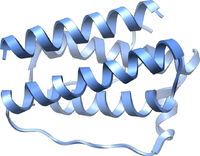
Carboxylated and undercarboxylated osteocalcin in metabolic complications of human obesity and prediabetes
Sign Up to like & getrecommendations! Published in 2017 at "Diabetes/Metabolism Research and Reviews"
DOI: 10.1002/dmrr.2862
Abstract: Carboxylated osteocalcin (Gla‐OC) participates in bone remodeling, whereas the undercarboxylated form (Glu‐OC) takes part in energy metabolism. This study was undertaken to compare the blood levels of Glu‐OC and Gla‐OC in nonobese, healthy obese, and… read more here.
Keywords: metabolic complications; complications human; osteocalcin metabolic; undercarboxylated osteocalcin ... See more keywords

Are we close to defining a metabolomic signature of human obesity? A systematic review of metabolomics studies
Sign Up to like & getrecommendations! Published in 2019 at "Metabolomics"
DOI: 10.1007/s11306-019-1553-y
Abstract: IntroductionObesity is a disorder characterized by a disproportionate increase in body weight in relation to height, mainly due to the accumulation of fat, and is considered a pandemic of the present century by many international… read more here.
Keywords: systematic review; signature; obesity; human obesity ... See more keywords

Pinitol alleviates systemic inflammatory cytokines in human obesity by a mechanism involving unfolded protein response and sirtuin 1.
Sign Up to like & getrecommendations! Published in 2018 at "Clinical nutrition"
DOI: 10.1016/j.clnu.2017.09.015
Abstract: BACKGROUND & AIMS It is known that pinitol acts as a mediator of the insulin-signaling pathway, though little is known about its anti-inflammatory effect in human obesity. Therefore, this study aimed to evaluate the effect… read more here.
Keywords: protein; sirtuin; pinitol alleviates; human obesity ... See more keywords

Novel adipokines: methodological utility in human obesity research
Sign Up to like & getrecommendations! Published in 2017 at "International Journal of Obesity"
DOI: 10.1038/ijo.2017.68
Abstract: Background:Adipokines could pose a link between adiposity, systemic inflammation and metabolic disease risk. However, it is unclear whether representative biomarkers are methodologically suitable for use in human obesity research.Methods:We assessed the intra-individual reproducibility of selected… read more here.
Keywords: novel adipokines; adipokines methodological; obesity research; obesity ... See more keywords

Augmented capacity for peripheral serotonin release in human obesity
Sign Up to like & getrecommendations! Published in 2018 at "International Journal of Obesity"
DOI: 10.1038/s41366-018-0047-8
Abstract: Background/objectivesEvidence from animal studies highlights an important role for serotonin (5-HT), derived from gut enterochromaffin (EC) cells, in regulating hepatic glucose production, lipolysis and thermogenesis, and promoting obesity and dysglycemia. Evidence in humans is limited,… read more here.
Keywords: capacity; serotonin; glucose infusion; obesity ... See more keywords

CK2 modulates adipocyte insulin-signaling and is up-regulated in human obesity
Sign Up to like & getrecommendations! Published in 2017 at "Scientific Reports"
DOI: 10.1038/s41598-017-17809-w
Abstract: Insulin plays a major role in glucose metabolism and insulin-signaling defects are present in obesity and diabetes. CK2 is a pleiotropic protein kinase implicated in fundamental cellular pathways and abnormally elevated in tumors. Here we… read more here.
Keywords: insulin; human obesity; adipose tissue; ck2 ... See more keywords

Dysregulated adipokine secretory profile is associated with endothelial dysfunction in human obesity
Sign Up to like & getrecommendations! Published in 2020 at "European Heart Journal"
DOI: 10.1093/ehjci/ehaa946.3032
Abstract: Adipokines have been postulated as the potential mediators of the relationship between excess adiposity and vascular dysfunction. In obese patients, vascular dysfunction, characterized by impaired vasodilator responsiveness and/or increased endothelin (ET)-1-dependent vasoconstriction, is, in turn,… read more here.
Keywords: response; dysfunction; obese patients; vascular dysfunction ... See more keywords

Editorial: Are Rodent Models Fit for Investigation of Human Obesity and Related Diseases?
Sign Up to like & getrecommendations! Published in 2017 at "Frontiers in Nutrition"
DOI: 10.3389/fnut.2017.00058
Abstract: 1 UMR Physiologie de la Nutrition et du Comportement Alimentaire, AgroParisTech, INRA, Université Paris Saclay, Paris, France, 2 Metabolic Research Laboratories, Wellcome Trust-MRC Institute of Metabolic Science, University of Cambridge, Cambridge, United Kingdom, 3 University/BHF… read more here.
Keywords: rodent models; editorial rodent; investigation human; fit investigation ... See more keywords

HPA Axis Responsiveness Associates with Central Serotonin Transporter Availability in Human Obesity and Non-Obesity Controls
Sign Up to like & getrecommendations! Published in 2022 at "Brain Sciences"
DOI: 10.3390/brainsci12111430
Abstract: Background: Alterations of hypothalamic–pituitary–adrenal (HPA) axis activity and serotonergic signaling are implicated in the pathogenesis of human obesity and may contribute to its metabolic and mental complications. The association of these systems has not been… read more here.
Keywords: human obesity; axis responsiveness; obesity; responsiveness ... See more keywords